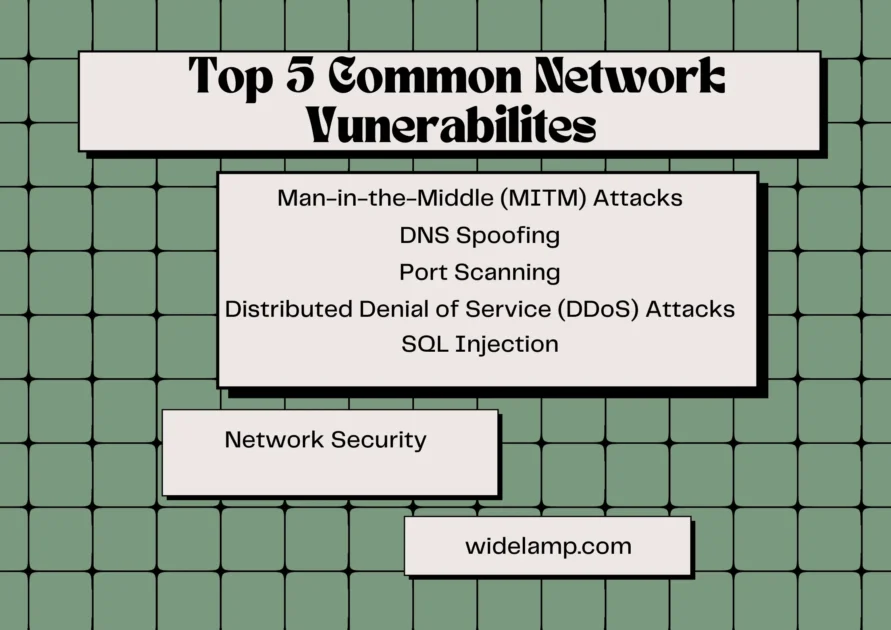|
Getting your Trinity Audio player ready...
|
In today’s world of connected networks and networks connecting with computers, phones, etc. in this article, I will explain the top 5 common network vulnerabilities in the network, we try to explain briefly, what are these common vulnerabilities and how to find them easily on our network, if I try to explain in common words these vulnerabilities are not easy to find but if you have some basic knowledge of network and tools then you can try to find these vulnerabilities.
You know the network is connected to a computer via a port, so you need to understand what is a port and how to find ports, if you don’t know you can simply connect with a comment in an article I will open a comment section where we are discussing about this article so everyone connect and talks to me if anyone has any query or question, you can also write an email on contact@widelamp.com.
Let’s start and try to find the top 5 common network vulnerabilities…..
More Articles Related to Network Security
What Are Network Vulnerabilities?
First, we will try to understand what is network vulnerabilities. Network vulnerabilities are weaknesses in a network’s hardware or software that can be exploited by attackers to gain unauthorized access, steal data, or cause harm. These vulnerabilities often involve ports, which are like doors that allow information to flow in and out of a networked device.
Man-in-the-Middle (MITM) Attacks
A Man-in-the-Middle (MITM) attack occurs when an attacker secretly intercepts and possibly alters communication between two parties. Imagine sending a secret message to a friend, but someone in the middle steals it, reads it, and then changes the message before passing it on. This can happen if you’re communicating over an insecure network, such as public Wi-Fi.
How It Relates to Ports:
Ports are used to send and receive information over a network. If an attacker gains access to an open port, they can monitor the traffic passing through it, enabling them to carry out an MITM attack. For example, if you use a website without HTTPS encryption, the attacker can intercept data traveling through the port.
Tools to Find MITM Attacks:
Wireshark: A popular tool for analyzing network traffic. It allows you to capture and inspect data packets flowing through a network. Suspicious traffic, such as unencrypted data, can indicate an MITM attack.
ARPwatch: A tool that detects ARP spoofing, a method attackers use to redirect network traffic for an MITM attack.
DNS SpoofingDNS Spoofing, also known as DNS cache poisoning
DNS Spoofing, also known as DNS cache poisoning, tricks your computer into connecting to a fake website instead of the real one. The DNS system translates web addresses (like www.widelamp.com) into IP addresses (numbers that identify websites). DNS spoofing happens when an attacker alters DNS records, redirecting you to a malicious website.
How It Relates to Ports:
DNS traffic usually flows through port 53. If attackers can manipulate the data passing through this port, they can trick your computer into visiting a fake website.
Tools to Find DNS Spoofing:
dnsspoof: Part of the dsniff toolset, this tool is specifically designed to monitor and detect DNS spoofing attacks.
DNSSEC: A security extension for DNS that helps detect and prevent DNS spoofing by verifying the authenticity of DNS responses.
Port Scanning
Port scanning is a technique used by attackers to find open or vulnerable ports on a device. By scanning ports, they can discover weak spots in a network that can be exploited. Open ports are like unlocked doors—if left unprotected, attackers can use them to access sensitive information or inject malware.
How It Relates to Ports:
Different ports serve different purposes. For example, port 80 is used for HTTP traffic, and port 443 is for HTTPS traffic. If an attacker finds an open port that isn’t properly secured, they can use it to launch an attack.
Tools to Perform Port Scanning:
Nmap: One of the most widely used tools for scanning ports. It helps network administrators detect open ports on their network and identify potential vulnerabilities.
Zenmap: A graphical interface for Nmap that makes it easier for beginners to perform port scans.
Distributed Denial of Service (DDoS) Attacks
A Distributed Denial of Service (DDoS) attack occurs when an attacker floods a network with so much traffic that it crashes or becomes unusable. This is like thousands of people all trying to enter a store at once, overwhelming the system.
How It Relates to Ports:
DDoS attacks often target specific ports. For instance, port 80 and port 443 (used for web traffic) are common targets. By overwhelming these ports, attackers can bring down a website or service.
Tools to Detect DDoS Attacks:
Snort: An open-source intrusion detection system that helps monitor network traffic for signs of a DDoS attack.
SolarWinds Network Performance Monitor: This tool helps network administrators detect unusual traffic patterns, which can indicate a DDoS attack.
Last but not least vulnerabilities
SQL Injection
An SQL injection attack occurs when attackers insert malicious code into a website’s input fields (like a login form) to manipulate or access the website’s database. This allows them to steal sensitive information, like passwords or credit card numbers.
How It Relates to Ports:
Web servers communicate with databases using ports. For example, port 1433 is commonly used for Microsoft SQL databases. If attackers can exploit weaknesses in a web server or database, they can inject harmful SQL commands through these ports.
Tools to Detect SQL Injection:
SQLMap: An open-source tool used to detect and exploit SQL injection vulnerabilities.
Burp Suite: A comprehensive tool for web security testing, including SQL injection detection.
These above are top 5 network common vulnerabilities, know it’s time to know how to find any type of vulnerability here are some tools that really help to find your network vulnerabilities
How to Find Vulnerabilities
To keep networks safe, it’s important to regularly check for vulnerabilities. Here are some tools and methods used to detect network vulnerabilities:
1. Penetration Testing: This is when security experts (or ethical hackers) simulate attacks on a network to find weaknesses. Tools like Metasploit can be used for this.
2. Vulnerability Scanners: Tools like OpenVAS or Nessus scan networks for known vulnerabilities.
3. Traffic Monitoring: Using tools like Wireshark, network traffic can be monitored for unusual activity, such as MITM attacks or DNS spoofing.
4. Firewall and Intrusion Detection Systems (IDS): Firewalls help block unauthorized access to ports, while IDS systems like Snort monitor networks for suspicious activity.
It’s Puzzle Time! – Solve these puzzles and comment below
Crossword Puzzle Clues
1. The type of attack where someone intercepts communication between two people: (12 letters)
2. A tool used to scan ports on a network: (4 letters)
3. The method attackers use to flood a website with too much traffic: (4 letters)

Q / A – Section
Questions that are very helpful for everyone and clear some doubts…
-
What is a network vulnerability?
A network vulnerability is a weakness in a network’s software or hardware that can be exploited by attackers to steal data, gain unauthorized access, or cause damage.
-
What is a Man-in-the-Middle (MITM) attack?
A Man-in-the-Middle (MITM) attack occurs when an attacker secretly intercepts and possibly alters the communication between two parties without them knowing.
-
How does a Man-in-the-Middle (MITM) attack relate to ports?
Ports are like doorways through which data flows in and out of devices. In an MITM attack, attackers can use open or unsecured ports to intercept and alter data being exchanged between two parties.
-
What is DNS Spoofing, and why is it dangerous?
DNS Spoofing, also known as DNS cache poisoning, tricks your device into visiting a fake website instead of the real one by tampering with DNS records. It’s dangerous because attackers can steal your information by redirecting you to a malicious site.
-
Which port is commonly targeted in DNS Spoofing attacks?
DNS traffic usually passes through port 53, which attackers can manipulate in DNS Spoofing attacks.
-
What is port scanning, and why do attackers use it?
Port scanning is the process of searching for open or vulnerable ports on a network. Attackers use it to find weak spots that they can exploit to gain unauthorized access or launch attacks.
-
What tool can be used to perform port scanning?
A popular tool for port scanning is Nmap, which helps find open ports on a network.
-
What is a Distributed Denial of Service (DDoS) attack?
A Distributed Denial of Service (DDoS) attack is when an attacker floods a network or server with so much traffic that it becomes overwhelmed and unusable.
-
How do DDoS attacks relate to ports?
In DDoS attacks, attackers send a large amount of traffic to specific ports (like port 80 or port 443) to overload the network or service, making it crash or become unavailable.
-
What is SQL Injection?
SQL Injection is an attack where an attacker sends harmful code through a website’s input fields (like a login form) to access or manipulate the website’s database.
-
How can you detect a Man-in-the-Middle (MITM) attack?
Tools like Wireshark and ARPwatch can be used to detect MITM attacks by monitoring network traffic for suspicious activities, such as unencrypted data being intercepted.
-
What tool can detect DNS Spoofing?
dnsspoof is a tool that can monitor network traffic and detect DNS Spoofing attacks.
-
Which tool is commonly used to detect and prevent SQL Injection?
SQLMap is a widely used tool to detect and exploit SQL Injection vulnerabilities.
-
What method is used to find weaknesses in a network by simulating an attack?
This method is called Penetration Testing, where ethical hackers try to exploit vulnerabilities in a network to find and fix weaknesses.
-
Why is it important to secure open ports on a network?
Open ports can act as entry points for attackers. If left unsecured, attackers can use these ports to launch attacks or steal sensitive information.




